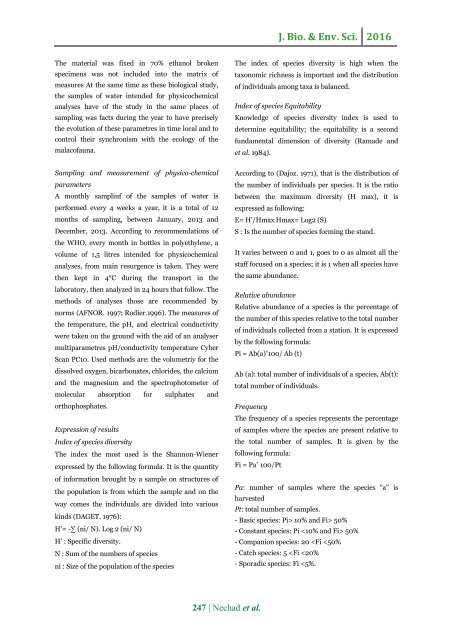Composition and structure of the malaco fauna of sources Ain Regarg, Sidi bouali and Tataw middle Atlas (Morocco)
Abstract An approach to the diversity of malacofauna associated with sources of Middle Atlas is carried out at three stations in the Fez-Boulemane region (Morocco) between January 2013 and December 2013. The selection of stations was based on their mapping, lithology, the physicochemical nature of their waters and on their proximity to human settlements. Six mollusc species were inventoried in this Malacological survey. Are Melanops is Praemorsa, Theodoxus numidica, Theodoxus numidica (Zebra), Horatiasp, Pisidium personatum and Pisidium casertanum. The descriptive analysis of the population of shellfish revealed a similarity between the biocenotic habitats Regrag Ain and Sidi Bouali. Biotic and abiotic factors in the distribution of snails are the calcium concentration, temperature, water and human activity that has clearly affected the malacofauna diversity of sources of the Middle Atlas.
Abstract
An approach to the diversity of malacofauna associated with sources of Middle Atlas is carried out at three stations in the Fez-Boulemane region (Morocco) between January 2013 and December 2013. The selection of stations was based on their mapping, lithology, the physicochemical nature of their waters and on their proximity to human settlements. Six mollusc species were inventoried in this Malacological survey. Are Melanops is Praemorsa, Theodoxus numidica, Theodoxus numidica (Zebra), Horatiasp, Pisidium personatum and Pisidium casertanum. The descriptive analysis of the population of shellfish revealed a similarity between the biocenotic habitats Regrag Ain and Sidi Bouali. Biotic and abiotic factors in the distribution of snails are the calcium concentration, temperature, water and human activity that has clearly affected the malacofauna diversity of sources of the Middle Atlas.
Create successful ePaper yourself
Turn your PDF publications into a flip-book with our unique Google optimized e-Paper software.
J. Bio. & Env. Sci. 2016<br />
The material was fixed in 70% ethanol broken<br />
specimens was not included into <strong>the</strong> matrix <strong>of</strong><br />
measures At <strong>the</strong> same time as <strong>the</strong>se biological study,<br />
<strong>the</strong> samples <strong>of</strong> water intended for physicochemical<br />
analyses have <strong>of</strong> <strong>the</strong> study in <strong>the</strong> same places <strong>of</strong><br />
sampling was facts during <strong>the</strong> year to have precisely<br />
<strong>the</strong> evolution <strong>of</strong> <strong>the</strong>se parametres in time local <strong>and</strong> to<br />
control <strong>the</strong>ir synchronism with <strong>the</strong> ecology <strong>of</strong> <strong>the</strong><br />
malac<strong>of</strong>auna.<br />
The index <strong>of</strong> species diversity is high when <strong>the</strong><br />
taxonomic richness is important <strong>and</strong> <strong>the</strong> distribution<br />
<strong>of</strong> individuals among taxa is balanced.<br />
Index <strong>of</strong> species Equitability<br />
Knowledge <strong>of</strong> species diversity index is used to<br />
determine equitability; <strong>the</strong> equitability is a second<br />
fundamental dimension <strong>of</strong> diversity (Ramade <strong>and</strong><br />
et al. 1984).<br />
Sampling <strong>and</strong> measurement <strong>of</strong> physico-chemical<br />
parameters<br />
A monthly samplinf <strong>of</strong> <strong>the</strong> samples <strong>of</strong> water is<br />
performed every 4 weeks a year, it is a total <strong>of</strong> 12<br />
months <strong>of</strong> sampling, between January, 2013 <strong>and</strong><br />
December, 2013. According to recommendations <strong>of</strong><br />
<strong>the</strong> WHO, every month in bottles in polyethylene, a<br />
volume <strong>of</strong> 1,5 litres intended for physicochemical<br />
analyses, from main resurgence is taken. They were<br />
<strong>the</strong>n kept in 4°C during <strong>the</strong> transport in <strong>the</strong><br />
laboratory, <strong>the</strong>n analyzed in 24 hours that follow. The<br />
methods <strong>of</strong> analyses those are recommended by<br />
norms (AFNOR. 1997; Rodier.1996). The measures <strong>of</strong><br />
<strong>the</strong> temperature, <strong>the</strong> pH, <strong>and</strong> electrical conductivity<br />
were taken on <strong>the</strong> ground with <strong>the</strong> aid <strong>of</strong> an analyser<br />
multiparametres pH/conductivity temperature Cyber<br />
Scan PC10. Used methods are: <strong>the</strong> volumetriy for <strong>the</strong><br />
dissolved oxygen, bicarbonates, chlorides, <strong>the</strong> calcium<br />
<strong>and</strong> <strong>the</strong> magnesium <strong>and</strong> <strong>the</strong> spectrophotometer <strong>of</strong><br />
molecular absorption for sulphates <strong>and</strong><br />
orthophosphates.<br />
Expression <strong>of</strong> results<br />
Index <strong>of</strong> species diversity<br />
The index <strong>the</strong> most used is <strong>the</strong> Shannon-Wiener<br />
expressed by <strong>the</strong> following formula. It is <strong>the</strong> quantity<br />
<strong>of</strong> information brought by a sample on <strong>structure</strong>s <strong>of</strong><br />
<strong>the</strong> population is from which <strong>the</strong> sample <strong>and</strong> on <strong>the</strong><br />
way comes <strong>the</strong> individuals are divided into various<br />
kinds (DAGET. 1976):<br />
H’= -∑ (ni/ N). Log 2 (ni/ N)<br />
H’ : Specific diversity.<br />
N : Sum <strong>of</strong> <strong>the</strong> numbers <strong>of</strong> species<br />
ni : Size <strong>of</strong> <strong>the</strong> population <strong>of</strong> <strong>the</strong> species<br />
According to (Dajoz. 1971), that is <strong>the</strong> distribution <strong>of</strong><br />
<strong>the</strong> number <strong>of</strong> individuals per species. It is <strong>the</strong> ratio<br />
between <strong>the</strong> maximum diversity (H max), it is<br />
expressed as following:<br />
E= H’/Hmax Hmax= Log2 (S)<br />
S : Is <strong>the</strong> number <strong>of</strong> species forming <strong>the</strong> st<strong>and</strong>.<br />
It varies between 0 <strong>and</strong> 1, goes to 0 as almost all <strong>the</strong><br />
staff focused on a species; it is 1 when all species have<br />
<strong>the</strong> same abundance.<br />
Relative abundance<br />
Relative abundance <strong>of</strong> a species is <strong>the</strong> percentage <strong>of</strong><br />
<strong>the</strong> number <strong>of</strong> this species relative to <strong>the</strong> total number<br />
<strong>of</strong> individuals collected from a station. It is expressed<br />
by <strong>the</strong> following formula:<br />
Pi = Ab(a) * 100/ Ab (t)<br />
Ab (a): total number <strong>of</strong> individuals <strong>of</strong> a species, Ab(t):<br />
total number <strong>of</strong> individuals.<br />
Frequency<br />
The frequency <strong>of</strong> a species represents <strong>the</strong> percentage<br />
<strong>of</strong> samples where <strong>the</strong> species are present relative to<br />
<strong>the</strong> total number <strong>of</strong> samples. It is given by <strong>the</strong><br />
following formula:<br />
Fi = Pa * 100/Pt<br />
Pa: number <strong>of</strong> samples where <strong>the</strong> species "a" is<br />
harvested<br />
Pt: total number <strong>of</strong> samples.<br />
- Basic species: Pi> 10% <strong>and</strong> Fi> 50%<br />
- Constant species: Pi 50%<br />
- Companion species: 20


















